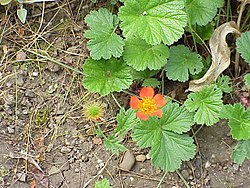Difference between revisions of "Geum"
| Line 1: | Line 1: | ||
| + | Geum (probably originally from Greek, geuo, to have a taste; referring to the roots). Rosaceae. Hardy border and rock plants, some of which are valued for their bright red flowers, some for their pure yellow flowers, others for their long plumy fruits. | ||
| + | |||
| + | Herbs, with a perennial rhizome, sometimes stoloniferous: root-lvs. crowded, odd-pinnate, the alternate lobes often smaller, terminal ones largest; st.-lvs. few, mostly of 3 lfts. or bract-like: fls. 1-2 in. across, solitary or corymbose or cymose; calyx persistent, its tube nearly hemispheric, usually 5-lobed; petals 5, nearly or quite round, longer than the calyx: fr. bunched on a short receptacle, frequently plumed.— More than 50 species, mostly in temperate and frigid regions. | ||
| + | |||
| + | The plumy kinds are all contained in the subgenus Sieversia. G. chiloense is the best species, and in the gardens is commonly seen in double forms. A gardener writes that "inferior forms show scarcely any duplicity." Geums are of easy culture, and are propagated by division or seed. It is said that they hybridize freely if grown together. The dwarf kinds are suited only to the rockery. Correvon, of Geneva, Switzerland, writes that G. reptans is one of the best of the rockery kinds, and needs full sunlight. For G. triflorum he advises half exposure to sun and a light, moist soil. G. rivale grows naturally in marshy places. | ||
| + | |||
| + | G. atrococcineum, Hort., may be a typographical error for G. atrosanguineum.- | ||
| + | G. atrosanguineum, Hort., is presumably a form of G. chiloense, with darker fls. than the type, and sold mostly if not entirely, in its double condition. G. bulgaricum, Hort.,=(?). G. ewenii has light orange fls. and is said to be a good border plant. – G. japonicum, Thunb., is sold, but little known. St. flexuose, hirsute: lvs. 3-5-lobed, hirsute: fls. erect, yellow petals, as long as the calyx: fr. hirsute, awned, recurved. Japan. | ||
| + | |||
| + | Wilhelm Miller. | ||
| + | N. Taylor. | ||
| + | |||
:''For the river, see [[Geum River]].'' | :''For the river, see [[Geum River]].'' | ||
{{Taxobox | {{Taxobox | ||
Revision as of 04:21, 6 September 2009
Geum (probably originally from Greek, geuo, to have a taste; referring to the roots). Rosaceae. Hardy border and rock plants, some of which are valued for their bright red flowers, some for their pure yellow flowers, others for their long plumy fruits.
Herbs, with a perennial rhizome, sometimes stoloniferous: root-lvs. crowded, odd-pinnate, the alternate lobes often smaller, terminal ones largest; st.-lvs. few, mostly of 3 lfts. or bract-like: fls. 1-2 in. across, solitary or corymbose or cymose; calyx persistent, its tube nearly hemispheric, usually 5-lobed; petals 5, nearly or quite round, longer than the calyx: fr. bunched on a short receptacle, frequently plumed.— More than 50 species, mostly in temperate and frigid regions.
The plumy kinds are all contained in the subgenus Sieversia. G. chiloense is the best species, and in the gardens is commonly seen in double forms. A gardener writes that "inferior forms show scarcely any duplicity." Geums are of easy culture, and are propagated by division or seed. It is said that they hybridize freely if grown together. The dwarf kinds are suited only to the rockery. Correvon, of Geneva, Switzerland, writes that G. reptans is one of the best of the rockery kinds, and needs full sunlight. For G. triflorum he advises half exposure to sun and a light, moist soil. G. rivale grows naturally in marshy places.
G. atrococcineum, Hort., may be a typographical error for G. atrosanguineum.- G. atrosanguineum, Hort., is presumably a form of G. chiloense, with darker fls. than the type, and sold mostly if not entirely, in its double condition. G. bulgaricum, Hort.,=(?). G. ewenii has light orange fls. and is said to be a good border plant. – G. japonicum, Thunb., is sold, but little known. St. flexuose, hirsute: lvs. 3-5-lobed, hirsute: fls. erect, yellow petals, as long as the calyx: fr. hirsute, awned, recurved. Japan.
Wilhelm Miller. N. Taylor.
- For the river, see Geum River.
| Avens | ||||||||||||||
|---|---|---|---|---|---|---|---|---|---|---|---|---|---|---|
 Geum coccineum flower, foliage and immature fruit | ||||||||||||||
| Plant Info | ||||||||||||||
|
| ||||||||||||||
| Scientific classification | ||||||||||||||
| ||||||||||||||
| Species | ||||||||||||||
| About 50; see text |
Geum (Avens) is a genus of about 50 species of perennial herbaceous plants in the rose family Rosaceae, native to Europe, Asia, North and South America, Africa and New Zealand. They are closely related to Potentilla and Fragaria.
Geum species are used as food plants by the larvae of some Lepidoptera species including Grizzled Skipper.
- Species
- Geum aleppicum - Yellow Avens
- Geum bulgaricum
- Geum calthifolium
- Geum canadense - White Avens
- Geum chiloense
- Geum coccineum - Red Avens
- Geum elatum
- Geum heterocarpum
- Geum japonicum
- Geum leiospermum
- Geum macrophyllum - Largeleaf Avens
- Geum molle
- Geum montanum - Alpine Avens
- Geum parviflorum
- Geum peckii
- Geum pentapetalum
- Geum pyrenaicum
- Geum reptans - Creeping Avens
- Geum rhodopeum
- Geum rivale - Water Avens
- Geum rossii
- Geum sikkimense
- Geum sylvaticum
- Geum triflorum - Purple Avens
- Geum turbinatum
- Geum uniflorum
- Geum urbanum - Wood Avens or Herb Bennet
- Geum virginianum - Virginia Avens